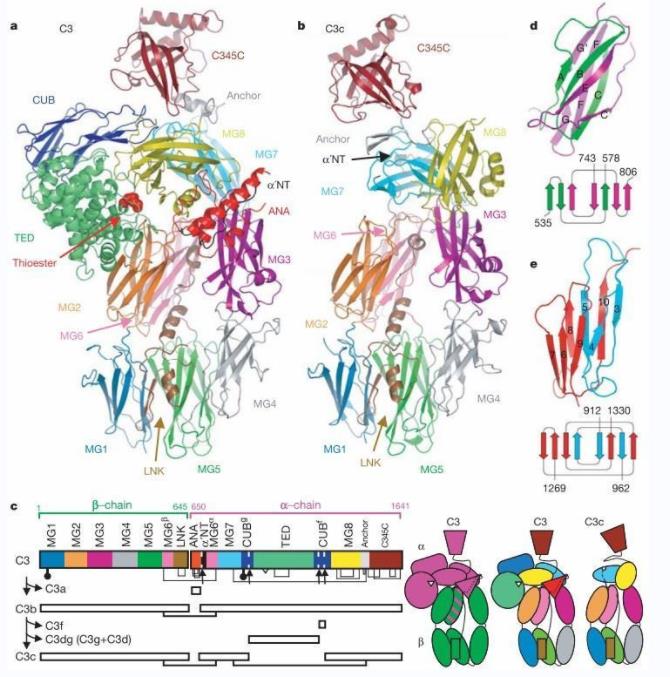What is C3 Protein
Within the intricate tapestry of the human body, protein plays a crucial role in maintaining balance and function. One protein that stands out is complement component 3 (or C3), a multifaceted molecule with multiple functions and effects in health and disease.
C3 is an important protein in the human immune system. It belongs to the complement system, a complex network of proteins that work together to protect the body from infection and promote the clearance of damaged cells. C3 is a multifunctional protein that plays a central role in innate and adaptive immune responses.
Understanding the structure of C3 is critical to elucidating its complex functions. C3 is a glycoprotein with sugar molecules attached to its structure. Structurally, it consists of two main fragments: a larger α-chain and a smaller β-chain, which are connected by a thioester bond. The thioester bond is a unique feature of C3 and its activation is a key event in the complement cascade.
 Figure 1. Structures of human complement components C3 and C3c (Janssen, B., et al. 2005)
Figure 1. Structures of human complement components C3 and C3c (Janssen, B., et al. 2005)The Function of C3 Protein
The primary function of C3 is to serve as the central hub of the complement system, coordinating a series of events that lead to the elimination of pathogens and damaged cells. C3 plays a key role in opsonization, the process by which immune cells mark pathogens for destruction. Additionally, C3 is involved in the formation of the membrane attack complex (MAC), which forms pores in the cell membrane of pathogens, leading to their destruction.
C3 also participates in the inflammatory response by attracting immune cells to the site of infection. C3's dual role in recognizing and eliminating threats makes it a key player in the body's defense mechanisms.
C3-Related Diseases
C3 is essential for a robust immune response, and dysregulation of its activity may lead to various diseases.
- Atypical Hemolytic Uremic Syndrome (aHUS)
It is a rare disease characterized by abnormal blood clotting and damage to vital organs. In aHUS, mutations in genes encoding complement proteins, including C3, may lead to uncontrolled complement activation, leading to systemic complications.
- Age-related Macular Degeneration (AMD)
AMD is the leading cause of vision loss in the elderly. Studies have shown that abnormal complement activation, particularly that involving C3, contributes to the development of AMD.
C3 Related Signaling Pathways
The complement system functions through a complex cascade of events, and signaling pathways involving C3 are central elements of this process. Activation of C3 can occur through three main pathways: the classical pathway, the alternative pathway, and the lectin pathway.
The classical pathway is initiated by antibodies binding to antigens on the surface of pathogens, activating a series of complement proteins, ultimately leading to the cleavage and activation of C3. When C3 undergoes low-level hydrolysis, the alternative pathway is spontaneously activated, leading to the generation of C3b, a key component in the formation of MACs..
The lectin pathway is initiated when pattern recognition molecules, such as mannose-binding lectin, bind to pathogens. This triggers a cascade of reactions that converge with the classical pathway, leading to activation of C3.
Applications of C3 in Biomedical Research
- Diagnosis
In diagnosis, measuring levels of C3 and other complement proteins in the blood can provide valuable information about the status of the immune system. Abnormal C3 levels may indicate an underlying immune disorder or inflammatory condition, aiding early detection and intervention.
- Treatment
On the therapeutic side, targeting C3 has emerged as an exciting area of research for the treatment of complement-related diseases. Inhibitors of C3 activation are being developed to modulate the complement system and prevent excessive immune responses, particularly in conditions such as aHUS and AMD.
- Autoimmune Disease Research
C3-based therapies are being explored for their potential in autoimmune diseases, in which the immune system mistakenly attacks the body's own tissues. Researchers aim to restore immune balance and alleviate the symptoms of autoimmune diseases by modulating C3 activity.
C3 protein is a core and multifunctional component of the complement system, helping the body to defend against infection and maintain immune homeostasis. Its complex structure, diverse functions, relationship with disease, and signaling pathways make C3 a fascinating research topic for immunology and biomedical researchers. The continuous exploration of C3 protein is expected to solve various immune-related diseases and create a new era of targeted and personalized medicine.
Recommended Products for C3 Protein
| Cat.# | Species | Product name | Source (Host) | Tag |
|---|---|---|---|---|
| C3-603H | Human | Active Recombinant Human C3 | E.coli | N/A |
| C3-558H | Human | Recombinant Human C3 Protein, His/GST-tagged | E.coli | His/GST |
| C3-10522H | Human | Recombinant Human C3, His-tagged | E.coli | His |
| C3-10H | Human | Active Recombinant Human C3 protein, His-tagged | HEK293 | His |
| C3-1841H | Human | Recombinant Human C3 Protein, MYC/DDK-tagged | HEK293 | Myc/DDK |
| C3-1859H | Human | Active Recombinant Human C3 protein, His-Avi-tagged, Biotinylated | HEK293 | His-Avi |
| C3-559M | Mouse | Recombinant Mouse C3 Protein, His/GST-tagged | E.coli | His/GST |
| C3-7845R | Rat | Recombinant Rat C3 protein, His-tagged | E.coli | His |
| C3-4324R | Rabbit | Recombinant Rabbit C3 Protein | Yeast | N/A |
| C3-4325S | Swine | Recombinant Swine C3 Protein | Yeast | N/A |
Reference
- Janssen, B., et al. Structures of complement component C3 provide insights into the function and evolution of immunity. Nature. 2005, 437: 505–511.

